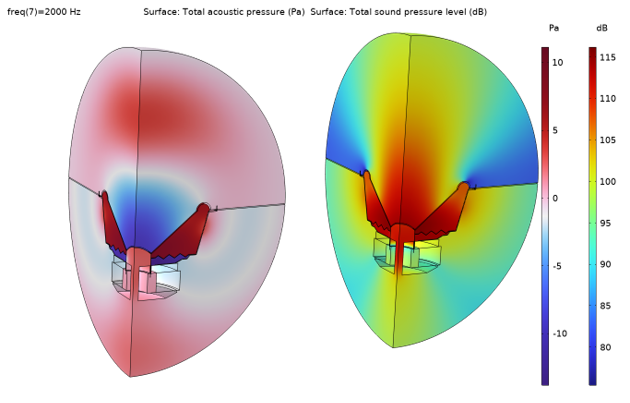Modeling Speaker Drivers in COMSOL Multiphysics®
In this 7-part, self-paced course, learn how to model speaker drivers and their performance in a working environment using COMSOL Multiphysics®and the add-on Acoustics Module and the AC/DC Module. Through step-by-step demonstrations in the software, comprehensive discussions, and thorough explanations, you will gain a solid foundation in the fundamentals of building such models. You will also learn about various specialized physics features and modeling techniques you can use to efficiently perform speaker analysis. An overview of the topics covered throughout the course is provided below.
A full 3D vibroelectroacoustic multiphysics model for a moving coil transducer (left), an analysis of its behavior when the driver is mounted in a bass reflex enclosure (center), and a shape optimization study of the spider to create a suspension system that behaves linearly all through the range of movement of the voice coil (right).
Part 1:Considerations for Detailed Finite Element Analyses
- The applicability of frequency-domain and time-dependent analyses
- Solving the problem in 2D versus 3D
- The required physics interfaces and multiphysics couplings
Part 2:Finite Element Frequency-Domain Analysis in 2D
- Setting up the physics for frequency-domain analysis in 2D axisymmetric space dimension
- Setting up the two-step study for frequency-domain perturbation analysis
- Meshing considerations
Part 3:Finite Element Frequency-Domain Analysis in 3D
- Coil geometry analysis for 3D models
- Symmetry features for reducing the model size
- Solver options for large models
Part 4:Finite Element Time-Dependent Analysis
- Differences in the physics setup (versus frequency-domain analysis) for transient study
- Setting up a moving mesh to capture geometry change
- Resolving time-dependent waves
- Setting up perfectly matched layers (PMLs) to model open space for transient analysis
- Calculating total harmonic distortion
Part 5:Modeling Speaker Drivers — Lumped Methods
- Available lumped approaches to represent the behavior of a speaker driver
- Coupling a lumped model with a finite element method (FEM) model
Part 6:Calculating the Small-Signal Parameters of a Speaker Driver from FEA
- Setting up analysis for extracting small-signal electrical parameters
- Setting up analysis for extracting small-signal mechanical parameters
Part 7:Calculating the Large-Signal Parameters of a Speaker Driver from FEA
- Setting up analysis for nonlinear mechanical compliance calculation
- Setting up analysis for nonlinear electrical parameter calculation

A plot of the total acoustic pressure and total sound pressure level for a speaker driver model built in Part 3 of this course.
请提交与此页面相关的反馈,或点击此处联系技术支持。

